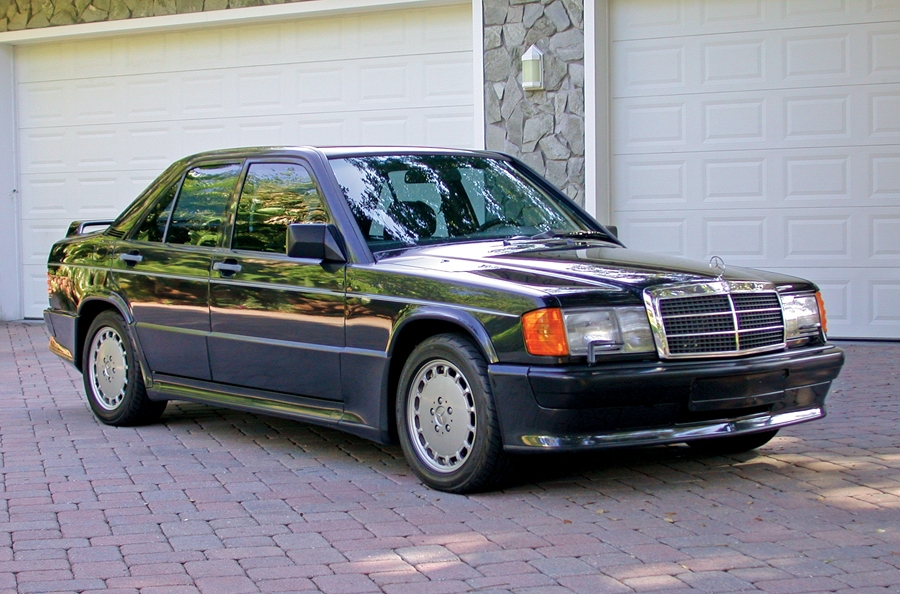
Most motoring enthusiasts are aware of the Mercedes-Benz 190E 2.3 16-valve cars. These models have acquired several nicknames, such as “Cosworth” or its diminutive “Cossie.” Although they have become famous, good examples remain elusive. But these are tough little cars, and refurbishing a driver is affordable, so you don’t have to “buy the best.”
These cars only came in Smoke Silver and Pearl Black. Powered by the Mercedes M102 4-cylinder engines, U.S.-market Cossies made 167 horsepower and European versions made 185. Production was from 1984 to 1987, with U.S. market introduction in 1986.
From raceway to freeway
Mercedes-Benz wanted to enter the 190E in Group B rallies, so they contracted Cosworth to develop a 320-horsepower engine — based on the existing M102 4-cylinder, 8-valve engine. Cosworth installed a new cylinder head with dual overhead camshafts and four valves per cylinder on the engine. The racing version was fast and powerful, hitting 0–60 mph in less than eight seconds.
After Mercedes became aware that Group B was not practical, they turned their eyes to the newly inaugurated German Touring Car Championship. Racing variants had to be based on a mass-produced road-going model, so Mercedes-Benz built a detuned version of the Cosworth racing engine to homologate the 190E. The roadgoing Cosworth was less powerful, but it still brought 167 horsepower to U.S.-market cars.
To race or appreciate?
There are two distinct types of end users for the Cosworth.
One group races and modifies them, and the other group appreciates their natural attributes. Many of the modified cars end up as unfinished projects that sell inexpensively enough to be improved. If you are buying a Cossie to go racing, buy a failed project and start from scratch. At this point you want to shop below $7,000.
If you’re buying to enjoy the car in its natural form, it helps to look for a solid car that has (hopefully) been unmolested. While you won’t be able to purchase a perfect car below $20k, you should look for an example with all specialty cosmetic and mechanical items intact. Smoke Silver cars sell at a slight discount.
Don’t forget what it really is
For all of the Cossie’s reliability and speed, it is still a 190E. Compared with other Mercedes, it is horrifically fragile. Climate-control systems are temperamental, dashboards crack and the vinyl peels off the door panels.
Other gremlins include window regulators, seat pads and plastic interior trim. Many owners also foolishly removed the rear self-leveling suspension, and parts, such as the lower ball joints and rear axle spindle bushings, fail over time.
Few Mercedes shops have the expertise to deal with suspension issues, and cobblers try to compensate with aftermarket springs, brakes and struts that compromise the dual-purpose nature of the 16-valve engine.
Many people gripe about the valve adjustments and timing chain. Timing chains were never the issue. Cossies had bad chain tensioners from new, and Mercedes-Benz now sells a replacement that ratchets the chain tight — instead of using pressurized oil as the previous variant did.
Valve adjustments require simple math and long attention spans — that’s the secret. When sorted, however, these cars are dead-reliable, stealthy and need little handholding.
All kinds of fun for under $25k
When shopping for a Cossie, be prepared to pay up to $25k or so for a sorted, well-kept example. Cosmetic condition trumps mileage in this case.
Bear in mind that there’s no such thing as a perfect example, so be prepared to deal with the aforementioned issues.
A realistic budget is in the $10,000–$15,000 range for a good driver, with $7,500 in your back pocket to turn the clock back to Daimler-Benz standards. After that, you have a fun Mercedes that will tolerate all kinds of driving without any issue — and steal your heart.
How do I know? One of my first loves was a 16-valve Cosworth. ♦
